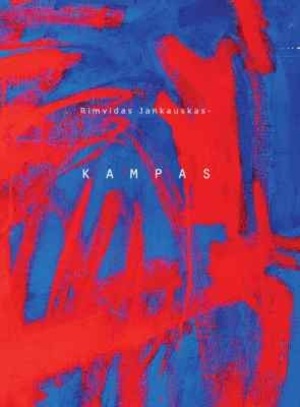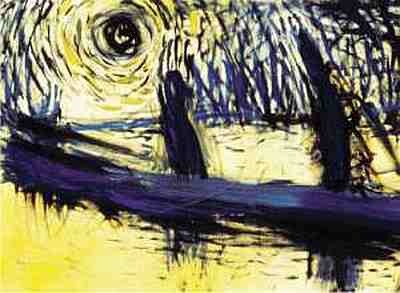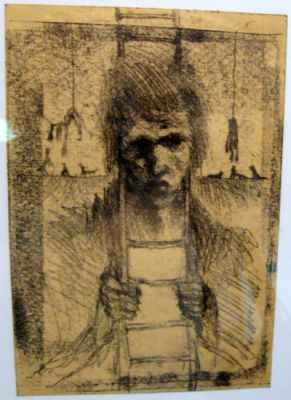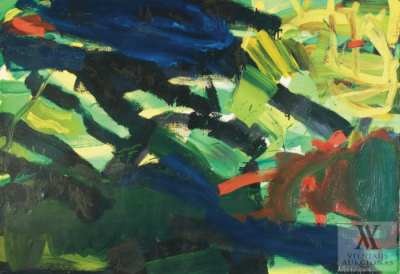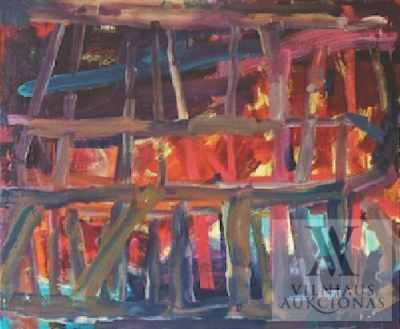THE WORLD IN LIGHT OF BLACK SUN OF KAMPAS 0
Several fragments from the life and creative work of Rimvidas Jankauskas-Kampas on the occasion of his first issued albumRūta Marcinkevičiūtė
www.kamane.lt , 2010 06 29
Artist Rimvydas Jankauskas-Kampas. Photo by V.Tamoliūnas
In brief: A real representative of Kaunas Bohemia whose lifestyle did not appear acceptable to policemen of Laisvės Alley as well as colleague artists. A man who lived and worked in a forlorn and cold synagogue in Kaunas, where he had constructed a hovel from his paintings. An artist who died soon after he reached the age of maturity as all of his strength was drained off by painting and alcohol. A painter whose works are almost impossible to buy as they are evaluated highly by art critics and collectors today.
It is a constant question which of these legends about the artist Rimvidas Jankauskas (1957-1993) called Kampas by everybody is close to the truth, when his paintings are presented in exhibitions. The exhibition of Kampas’ works open at Vilnius gallery Kunstkamera at the moment is no exception. True, it is not a thorough presentation of creative works of the artist but an exposition organised on the occasion of the recently published album of the artist’s works.
Album of works of R.Jankauskas-Kampas. Photo by R.Marcinkevičiūtė
The album issued by Vilnius auction was called in a laconic manner "Rimvydas Jankauskas - Kampas" and compiled in the same style too. The reader will find a short biography and bibliography, a list of works and about one hundred reproductions of the artist’s best works. However, it is impossible to find out who owns one or another work of Kampas from the list of works. Only the ownership of Vilnius and Kaunas museums has been marked.
Even though 17 years have passed since the death of Kampas, his name is mentioned more and more frequently while speaking about the classics of painting. Still, it is only now that a more serious glance is cast to his works and a thought is taken how Kampas’ paintings may be evaluated in the context of Lithuanian art. The new album is only the first step towards the cognition of his creative works. This is testified by the exhaustive but rather short introductory text of the art critic Rasa Žukienė, several recollections of friends and few thoughts of Kampas himself.
The album includes recollections of friends and acquaintances of Kampas taken down by the author of the article after the artist’s death: painter Jonas Gasiūnas, stage designer Jonas Arčikauskas, art photographer Gintaras Zinkevičius and others. After the presentation of the album of Kampas at Kunskamera gallery, the author decided to create one more variant of the set of recollections. During the presentation of the album the artist’s life and works were analysed by the compiler of the album, director of the Art Market Agency Simona Makselienė, art critic Raminta Jurėnaitė and the artist’s friends: architect Eugenijus (Simas) Miliūnas, painters Elena Balsiukaitė-Brazdžiūnienė and Antanas Obcarskas.
Album. Hearth of Painters’ Family Starts Glowing
"Rimvidas Jankauskas - Kampas has been recognised as one of the strongest Lithuanian expressionist painters by everybody. Still, not a single album of his works was issued until now. In fact, this book is only the beginning of work, which, I hope, will be continued by somebody. We have registered about 200 works of Kampas; about 100 reproductions are published. Therefore, many works have remained non-photographed and unregistered yet." \Simona\
R.Jankauskas-Kampas. "Self-portrait with the Ladder", 1981. Photo by R. Marcinkevičiūtė
"In my opinion, the new book of Kampas and the exhibition as well as this evening is not a thorough presentation of works of the artist to the society. It is rather the first sign that the hearth of painters’ family has finally stared glowing." \Simas\
R.Jankauskas-Kampas. "Windy Evening", 1991. Photo of Vilnius auction
Break Zone. How Kampas Found his Road
"The sixth and seventh decades of the 20th century were related with the movement of young people in the world. The feeling of freedom prevailed at the end of the century in our country. It was a possibility to free out from the hands of the empire. I believe that this also had a huge impact on the works of Rimas." \Elena\
"We participated in a plein-air in Baisogala collective farm along with Kampas, Arūnas Vaitkūnas and other Kaunas artists in autumn of 1988. Even though the conditions for creation were wonderful there, Kampas seemed to be depressed. He had graduated from the Art Institute recently and it was his first plein-air. He simply did not know what to do. While we stayed there, somebody invited us to a plein-air in Palanga organised by the Board of the Water Supply and Sewerage Water. We decided to participate in it. We worked in “a la prima” manner then. When Kampas saw our work, he decided to “play the fool” too. This was the beginning of “playing”. At the end of the plein-air, he presented many paintings with lightings and angles. Strontiums, cadmiums, red and black, wide strokes. This was how it started." \Antanas\
Creation. In European Time Behind the Iron Curtain
"Painting was tolerated only in the frame of mandatory themes at Vilnius Art Institute. Rimas was a very precise man, and his academic painting was fantastic. He drew much. He carried out all body studies, all this "glance" perfectly. He was interested in Japanese graphics and engravings a lot. He was an expert of Katsushika Hokusai and Utagawa Hiroshige." \Elena\
“When I heard the thought of Elena Balsiukaitė that classical Japanese woodcarvings were important to Kampas, I found an answer to the majority of questions. I always questioned myself from where the clear graphical structure of Kampas’ works emerged. The composition of classical Japanese engraving (looking from the perspective of today) was very modern, fragmented. Edgar Degas and other artists of the beginning of the 20th century were highly interested in Japanese engravings due to these unexpected fragmented compositions. This is where the fragmented compositions of Kampas could have emerged. He could not have seen originals of paintings of the neo-expressionist German group Neue Wilde – we were closed by the iron curtain at the time he started creating. He had to reach these creative solutions in other ways, to discover much on his own. Still, chronologically, his works coincide with the activity of the Neue Wilde." \Raminta\
Bohemia. Hero of H.Perruchot’s Books in Kaunas Synagogue
R.Jankauskas-Kampas. "A bridge", 1992. Photo of Vilnius auction
“Kampas appeared to me a typical hero of popular books about impressionists by Henri Perruchot. He was one of the artists who forgot his personal life and dedicated all the spiritual passion to creation. He burned in his dreams destroying himself completely. It seems to me that he was a completely phenomenal case in Lithuania. Moderation, coldness and reason is typical of Lithuanians. Meanwhile, Kampas gave away all his health and spirit to creation. His paintings are full of heart rather than intellectualism or conceptualism. It is a quality of increasing value these days as less and less of it remains.” \Simas\
"It is cruel. Six years for a painter is very little. Still, such was the fate. Otherwise, we would not have such works. This explains why the circulation of life and creation of Rimas was much faster and rushed.” \Elena\
Detective. Lost Trace of Majority of Works
"It is not true that it is impossible to buy valuable works of Kampas in Lithuania. Still, I would like to find out about the fate of those paintings that were transported away from Lithuania. Nobody knows what happened to them. They were rather cheap earlier; therefore, they could have appeared in accidental hands. It would be good to trace all threads for the general understanding of his works." \Raminta\
Importance. Fresh Air Let into Lithuanian Art Boxroom
Researchers of Kampas’ works R.Jurėnaitė and S.Makselienė. Photo by R.Marcinkevičiūtė
"Kampas let in some fresh air into Lithuanian painting. He encouraged other people to paint in a more liberal manner and to experiment more. It is not some direct stylistic or pedagogical impact. He served as a very strong impulse to realise that different painting could exist. The subtle and harmonious colours loved by the French school were used until Kampas. He was one of the first artists who started using such contemporary and open colour, the more aggressive manner of painting. Kampas was the first who ruined the equilibrium taken over from the French painting of the first half of the 20th century. It was a road to contemporary art. This is why his role in the development of our art is so significant. It is not stylistic influence but the change of the very attitude to art." \Raminta\
R.Jankauskas-Kampas. "Black Sun", 1993
